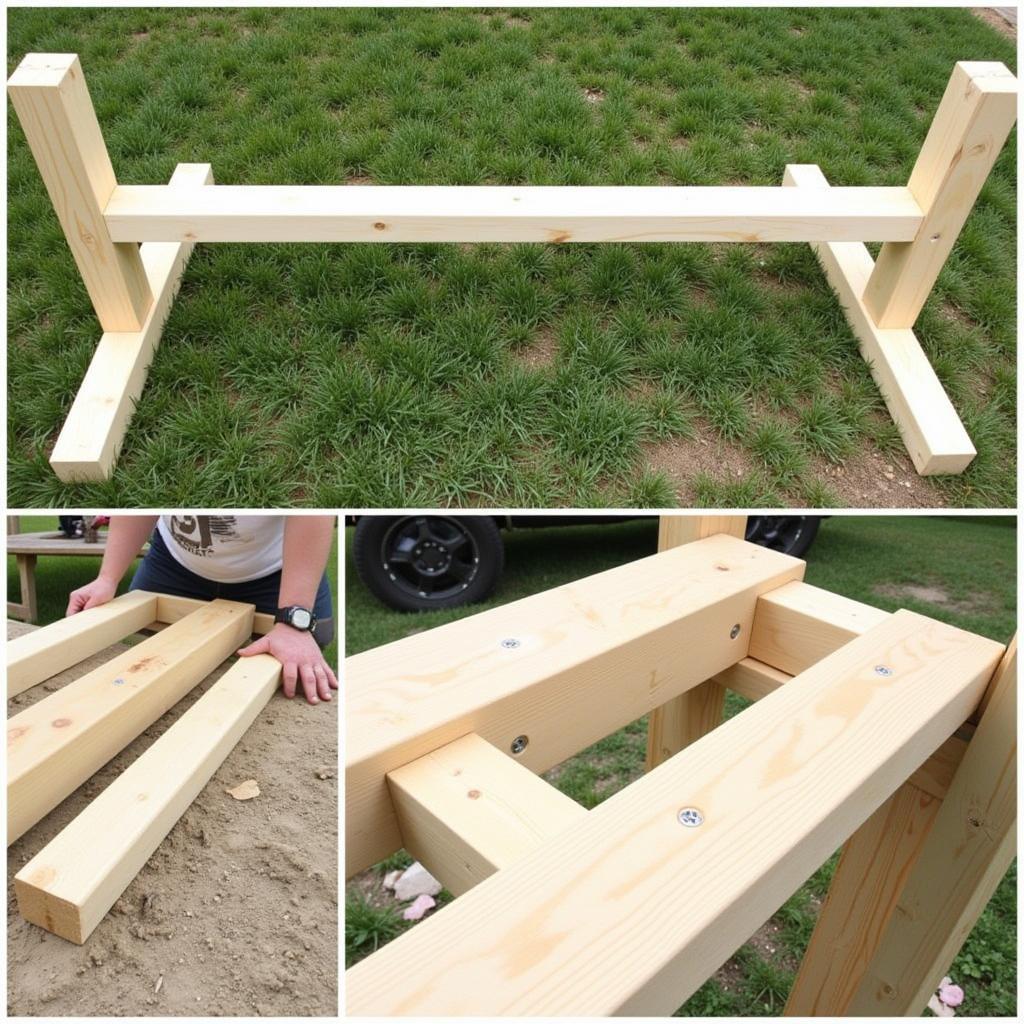Building a horse jump can be a rewarding experience, allowing you to customize your horse’s training and create a safe and engaging environment. Whether you’re a seasoned equestrian or just starting out, understanding the fundamentals of How To Build A Horse Jump is crucial for the safety and enjoyment of both horse and rider. This guide will walk you through the process, from choosing the right materials to constructing various types of jumps.
Choosing the Right Materials for Your Horse Jump
The materials you choose will determine the durability, safety, and overall aesthetic of your horse jump. Opting for high-quality, sturdy materials is essential to ensure the jump can withstand regular use and varying weather conditions. Pressure-treated lumber is an excellent choice for the frame, as it resists rot and insect damage. For the jump rails, PVC pipes are lightweight, affordable, and easily replaceable.
 Building the Frame of a Horse Jump
Building the Frame of a Horse Jump
Other suitable options include natural wood poles, which offer a more traditional look, and composite materials, known for their strength and durability. Avoid using materials that could splinter or break easily, posing a hazard to your horse. Always prioritize safety when selecting your materials.
Constructing a Basic Horse Jump: A Step-by-Step Guide
Building a basic horse jump is surprisingly straightforward, even for beginners. Start by cutting your lumber to the desired height and width for the jump standards. A good starting height is around 3 feet, and the width should be slightly wider than the expected jumping width.
- Assemble the frame by attaching the horizontal crosspieces to the vertical supports. Use screws and brackets to ensure a strong and stable connection.
- Once the frame is complete, attach jump cups or brackets to hold the rails. These should be positioned at equal heights on both standards.
- Insert your chosen rails into the cups. Ensure they are securely placed and can be easily knocked down if the horse makes contact.
Different Types of Horse Jumps: Exploring Your Options
Beyond the basic horse jump, there’s a wide array of jump styles you can build. From oxers to verticals and even water jumps, each type presents unique challenges and opportunities for training. Oxers, consisting of two or three rails placed at varying heights and distances, encourage the horse to stretch and improve their jumping form.
Vertical jumps, with a single rail, help develop the horse’s height and technique. Water jumps, although more complex to construct, offer a stimulating and refreshing challenge for more experienced horses. Remember to always consider your horse’s skill level and training goals when selecting the type of jump to build.
Maintaining Your Horse Jumps: Ensuring Longevity and Safety
Regular maintenance is essential to keep your horse jumps safe and functional. Check the frame and rails for any signs of wear and tear, such as cracks, splinters, or loose screws. Replace damaged components promptly to prevent accidents. Regularly repaint or treat the wood to protect it from the elements and prolong its lifespan.
Conclusion: Building Your Own Horse Jumps
Building a horse jump is a fantastic way to enhance your horse’s training and create a personalized jumping course. By following these guidelines and prioritizing safety, you can construct sturdy and engaging jumps that will benefit both you and your horse. Remember to always adapt the design and materials to suit your horse’s experience and training needs. Start building your own horse jumps today and take your equestrian journey to the next level! Interested in pre-built options? Check out our cross country horse jumps for sale. You might also find our DIY resources on horse jumps diy helpful.
FAQ
- What is the ideal height for a beginner horse jump?
- What materials are best for constructing horse jump rails?
- How can I make my horse jumps more challenging?
- What safety precautions should I take when building horse jumps?
- How often should I maintain my horse jumps?
- Where can I find more information on building homemade jumps for horses?
- What kind of jumps are used in horse shows in michigan?
Common Scenarios and Questions
-
Scenario: A horse is hesitant to approach a new jump.
-
Question: How can I encourage my horse to jump confidently?
-
Scenario: The jump rails keep falling off during training.
-
Question: How can I ensure my jump rails are secure?
Further Resources and Questions
- Explore additional articles on how to build horse jumps.
Need Help? Contact Us!
For assistance with building your dream horse jump, contact us at:
Phone: 0772127271
Email: [email protected]
Address: QGM2+WX2, Vị Trung, Vị Thuỷ, Hậu Giang, Việt Nam.
Our customer service team is available 24/7.